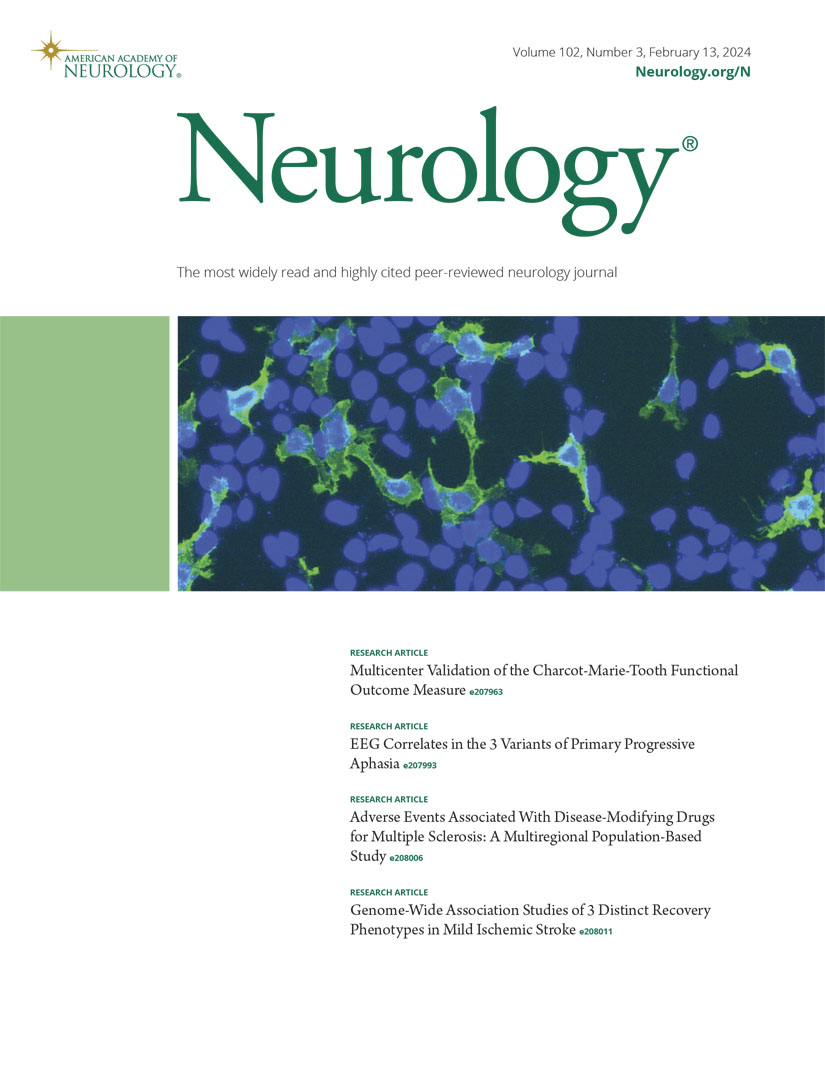Three-Dimensional Maps of the Lenticulostriate Artery Territory.
IF 7.7
1区 医学
Q1 CLINICAL NEUROLOGY
引用次数: 0
Abstract
BACKGROUND AND OBJECTIVES Accurate knowledge of the cerebral vascular territories is foundational to stroke care. Yet, precise digital reference maps are not widely accessible, especially for subcortical structures. To address this shortcoming, we constructed 3-dimensional vascular territory maps of the MCA perforators-the lenticulostriate arteries (LSAs). METHODS Nineteen LSA infarcts were demarcated on DWI scans and then normalized onto a standard 3-dimensional template brain. Normalized infarct volumes were then superimposed to create infarct density maps (heatmaps). RESULTS LSA territory heatmaps display the spatial distribution of infarct frequency of the entire territory and highlight its spatially consistent subterritories: medial group, lateral group-rostral, and lateral group-caudal. The maps show each territory's most commonly affected core, as well as their typical shape, boundary, and variability. DISCUSSION The LSA territory maps can be used for education, clinical reference, or research. They can be explored 3-dimensionally on any web browser or downloaded for use. In addition, we present a framework for understanding infarcts within the LSA system based on microvascular architecture.透镜状纹状动脉区域的三维地图。
背景与目的对脑血管区域的准确认识是卒中治疗的基础。然而,精确的数字参考地图并没有被广泛使用,特别是对于皮质下结构。为了解决这一缺陷,我们构建了MCA穿支-透镜状纹状动脉(LSAs)的三维血管区域图。方法在DWI扫描上对19例LSA梗死灶进行划分,并将其归一化为标准的三维模板脑。然后将归一化的梗死体积叠加成梗死密度图(热图)。结果slsa区域热图显示了整个区域梗死频率的空间分布,并突出了其空间一致性的亚区域:内侧组、侧组-吻侧和侧组-尾侧。这些地图显示了每个地区最常受影响的地核,以及它们的典型形状、边界和可变性。LSA区域图可用于教育、临床参考或研究。它们可以在任何网络浏览器上进行三维探索或下载使用。此外,我们提出了一个基于微血管结构的理解LSA系统内梗死的框架。
本文章由计算机程序翻译,如有差异,请以英文原文为准。
求助全文
约1分钟内获得全文
求助全文
来源期刊

Neurology
医学-临床神经学
CiteScore
12.20
自引率
4.00%
发文量
1973
审稿时长
2-3 weeks
期刊介绍:
Neurology, the official journal of the American Academy of Neurology, aspires to be the premier peer-reviewed journal for clinical neurology research. Its mission is to publish exceptional peer-reviewed original research articles, editorials, and reviews to improve patient care, education, clinical research, and professionalism in neurology.
As the leading clinical neurology journal worldwide, Neurology targets physicians specializing in nervous system diseases and conditions. It aims to advance the field by presenting new basic and clinical research that influences neurological practice. The journal is a leading source of cutting-edge, peer-reviewed information for the neurology community worldwide. Editorial content includes Research, Clinical/Scientific Notes, Views, Historical Neurology, NeuroImages, Humanities, Letters, and position papers from the American Academy of Neurology. The online version is considered the definitive version, encompassing all available content.
Neurology is indexed in prestigious databases such as MEDLINE/PubMed, Embase, Scopus, Biological Abstracts®, PsycINFO®, Current Contents®, Web of Science®, CrossRef, and Google Scholar.
 求助内容:
求助内容: 应助结果提醒方式:
应助结果提醒方式:


